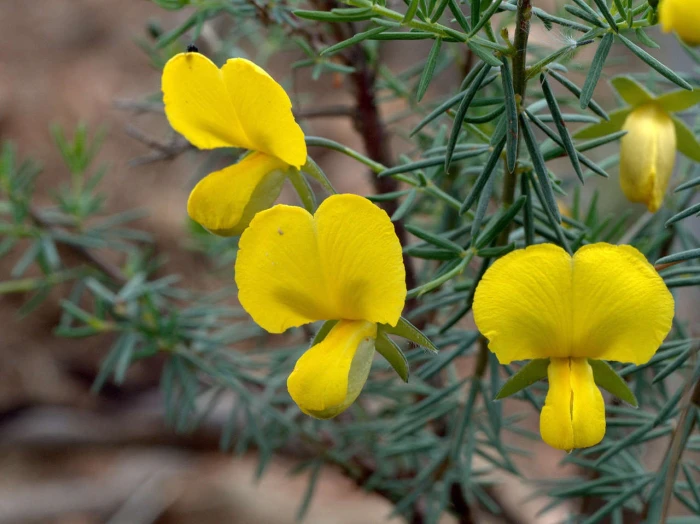Common Wedge-Pea
(Gompholobium huegelii)
Common Wedge-Pea (Gompholobium huegelii)
/
/

Lorraine Phelan
CC BY 4.0
Image By:
Lorraine Phelan
Recorded By:
Copyright:
CC BY 4.0
Copyright Notice:
Photo by: Lorraine Phelan | License Type: CC BY 4.0 | License URL: http://creativecommons.org/licenses/by/4.0/ | Rights Holder: Lorraine Phelan | Publisher: iNaturalist | Date Created: 2017-10-24T14:17:26Z |
























Estimated Native Range
Climate Requirements for Coon Rapids, Minnesota
| This Plant | Your Site | Plant Suitability for Your Location | ||
|---|---|---|---|---|
| • Precipitation | 29" - 35" | 30" | You should be able to grow this plant with no additional irrigation. | Excellent |
| • High Temp. | 71°F - 82°F | 84°F | Your summer temperatures are normal for this plant. | Excellent |
| • Low Temp. | 32°F - 43°F | 2°F | Your winter temperatures may be too cold for this plant | Too cold |
This plant may not grow well at your location - your winters are too cold.
Summary
Gompholobium huegelii, commonly known as Common Wedge-pea, is a perennial shrub native to a variety of habitats including heathlands, open forests, and forest margins in southeastern Australia, particularly in Queensland, New South Wales, Victoria, and Tasmania. It typically grows to a height of up to 3 feet (approximately 1 meter) with a similar spread. The plant has an erect or spreading habit and features trifoliate leaves that are characteristic of the Fabaceae family. Its flowers are pea-like, ranging in color from cream to yellow and occasionally greenish, and are known for their beauty during the long blooming season from September to April.
Common Wedge-pea is valued for its vibrant flowers and extended flowering period, making it a popular choice for native gardens, informal hedges, and as a feature plant in mixed borders. It is also used in restoration projects due to its adaptability to different soil types and conditions. Gompholobium huegelii prefers well-drained soils and can tolerate a range of light conditions from full sun to part shade. While it is relatively low-maintenance, it benefits from occasional pruning to maintain its shape and promote denser growth. There are no major disease problems associated with this plant, but it can be sensitive to root disturbance once established.CC BY-SA 4.0
Common Wedge-pea is valued for its vibrant flowers and extended flowering period, making it a popular choice for native gardens, informal hedges, and as a feature plant in mixed borders. It is also used in restoration projects due to its adaptability to different soil types and conditions. Gompholobium huegelii prefers well-drained soils and can tolerate a range of light conditions from full sun to part shade. While it is relatively low-maintenance, it benefits from occasional pruning to maintain its shape and promote denser growth. There are no major disease problems associated with this plant, but it can be sensitive to root disturbance once established.CC BY-SA 4.0
Plant Description
- Plant Type: Shrub
- Height: 1.5-3 feet
- Width: 1.5-2.5 feet
- Growth Rate: Moderate
- Flower Color: Yellow
- Flowering Season: Spring, Summer
- Leaf Retention: Evergreen
Growth Requirements
- Sun: Full Sun, Part Shade
- Water: Medium
- Drainage: Medium, Fast
Common Uses
Border Plant, Butterfly Garden, Low Maintenance, Rock Garden, Showy Flowers
Natural Habitat
Heathlands, open forests, and forest margins in southeastern Australia
Other Names
Common Names: Wedge Pea
Scientific Names: Gompholobium huegelii, Glycine latifolius, Gompholobium huegelii var. leptophyllum, Gompholobium latifolium, Gompholobium pedunculare
GBIF Accepted Name: Gompholobium huegelii